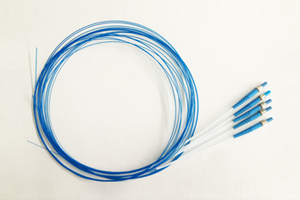Fractionated Laser Skin Resurfacing Treatment Complications: A Review
Keywords:laser, skin, fiber, medical, Time:03-11-2015The concept of fractional photothermolysis, coined in 2004 by Manstein and colleagues, has revolu
tionized the field of laser skin resurfacing by providing the ability to obtain significant clinical results with minimal post-treatment recovery.3 This technique generates microthermal treatment zones (MTZs) in the dermis, which are columns of thermally denatured skin of controlled width and depth. The small surface area of each wound results in rapid wound healing from a reservoir of viable keratinocytes in the untreated islands of surrounding skin.

Fractionated technology has led to the development of a number of nonablative and ablative devices, as reflected in Table 1.4,5 Initial reports on the nonablative fractionated devices emphasized almost complete absence of prolonged side effects,6,7 but more recent publications involving ablative fractionated lasers have shown that clinical complications can occur.8–10 Given that some of these complications are potentially avoidable, the importance of their recognition by health professionals cannot be overemphasized (Table 2).
Prolonged Erythema
Immediate post-treatment erythema is an expected consequence of fractionated laser skin resurfacing that usually resolves within 3 to 4 days.6 Prolonged erythema is defined as post-treatment erythema that persists longer than 4 days with nonablative resurfacing and beyond 1 month with ablative treatment.
It has been reported in fewer than 1% of nonablative7 and more than 12.5% of ablative laser-treated patients, although erythema typically resolves in these latter cases within 3 months.11,12 Although traditional nonfractionated laser resurfacing tends to be associated with longer-lasting postoperative erythema, fractionated laser resurfacing treatments that use multiple laser passes or inadvertent stacking also increase the risk of prolonged erythema.
The intensity and duration of postfractional laser erythema can be decreased with the use of a 590-nmwavelength light-emitting diode (LED) array.14 In asplit-face study of 20 patients, LED photomodulation was shown to reduce the intensity of erythema in all treated facial halves at the 24-hour postoperative visit. In six patients, total resolution of erythema was 24 to 48 hours faster after LED treatment than in untreated control facial halves.14 In addition, given its antiinflammatory properties, topical ascorbic acid should be considered because a previous study reported less severe and shorter postablative laser resurfacing erythema with its use.
Infection
Given that viral, bacterial, and fungal infections usually present during the first postoperative week, proper identification and treatment are essential to avoid further complications, including delayed wound healing, scarring, co-infection with other pathogens, and systemic dissemination.
The rate of herpes simplex virus (HSV) infection, the most common type of infection after fractional laser skin resurfacing, has been reported in 0.3% to 2% of cases.7,16 In contrast, infection rates with traditional (nonfractionated) laser treatment are higher, with 2% to 7% of cases developing HSVreactivation.17,18 Patients may not present with classic herpetiform vesicopustules but instead may demonstrate only superficial erosions that develop during the first week after treatment.16 To minimize the risk of HSV reactivation with fractional resurfacing, antiviral prophylaxis should be administered when a prior history of facial HSV is documented or if full-face ablative laser procedures are performed. In these patients, oral antiviral agents should be initiated concomitant with or 1 day before treatment and continued for 5 to 7 days. This approach can minimize the rate of patient complications to less than 0.5% in healthy individuals with no prior history of HSV,7,16 although in individuals who have had HSV before, 7% will show reactivation if prophylactic therapy is not initiated as outlined above.7 Furthermore, fractional skin resurfacing should not be performed on patients with active HSV infection, given the risk of HSV exacerbation.
In cases in which herpetic outbreak occurs despite prophylaxis, optimization of treatment doses or switching to another antiviral agent may be required, because viral resistance to the initially prescribed drug is possible, with a high risk of subsequent scarring.18 Although not yet reported with fractional skin resurfacing, in rare instances of herpetic dissemination, intravenous antiviral therapy and further hospitalization may be necessary.
More Disposable Bare Fiber,Diffuser Fiber,Holmium Fiber,Polyimide Fiber,Side Fire Fiber information,please contact Medfibers
Related Articles
- The Effect of Low Level Laser Therapy on the Rate of Tooth Movement and Pain Perception during Canine Retraction
- Interventional laser surgery for oral potentially malignant disorders: a longitudinal patient cohort study
- Low level laser therapy in dentistry
- Effectiveness of diode laser as adjunctive therapy to scaling root planning in the treatment of chronic periodontitis
- An Innovative Device for Fractional CO2 Laser Resurfacing:Medical fiber Application
- The clinical observation of semi-conductor laser treatment of hypersensitive dentine
- 980 nm diode lasers in oral and facial practice: current state of the science and art
- APPLICATION OF Nd–YAG LASER TREATMENT FOR ORAL LEUKOPLAKIA
- Indications and limitations of Er:YAG laser applications in dentistry
- 980 nm diode lasers in oral and facial practice: current state of the science and art
